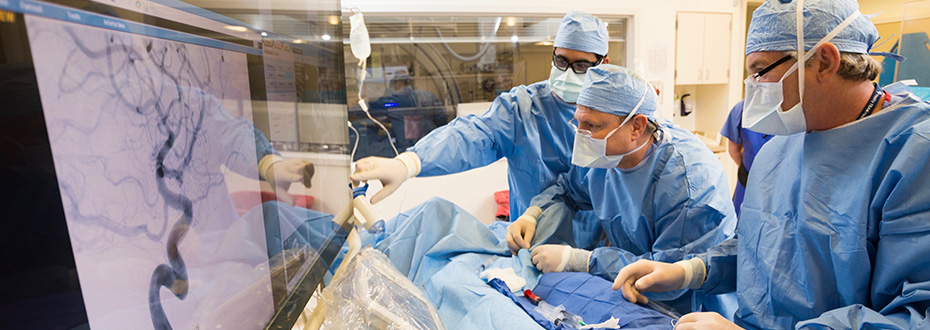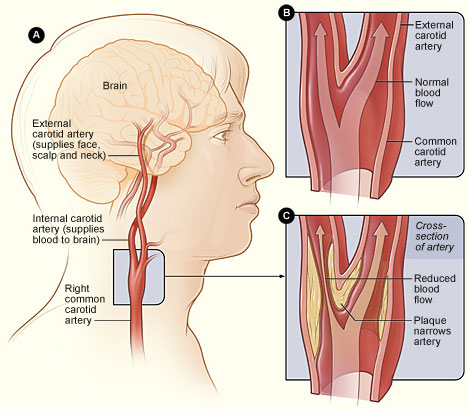Carotid Endarterectomy and Stent

The OHSU Brain Institute’s cerebrovascular team has deep expertise in treating carotid artery disease to prevent stroke. We offer:
- Skilled vascular surgeons who perform more than 60 carotid endarterectomies a year.
- The region's most active practice in carotid angioplasty and stenting.
- The most advanced imaging.
- Access to clinical trials to test promising new approaches for carotid disease, including the Crest-2 trial.
- Expert monitoring and follow-up care.
What is carotid artery disease?
The carotid arteries are large blood vessels, one on each side of the neck, that carry blood to the brain. Carotid artery disease occurs when plaque (fatty deposits) builds up inside them (atherosclerosis). This can reduce or block blood flow to the brain, causing a stroke.
Carotid artery disease, also called carotid stenosis or carotid atherosclerosis, is a major cause of stroke in the United States.

Signs and symptoms
Early carotid artery disease may have no symptoms. Your doctor may hear an abnormal whooshing sound called a bruit (pronounced brew-ee) with a stethoscope. A transient ischemic attack (TIA) or a stroke may be the first sign of disease.
What are carotid endarterectomy and stenting?
Carotid endarterectomy and carotid angioplasty and stenting are treatments for carotid artery disease.
Carotid endarterectomy: This surgery removes plaque from inside the carotid artery. It increases blood flow to the brain and reduces the risk of stroke.
Carotid angioplasty and stenting: This minimally invasive procedure improves blood flow through carotid arteries blocked by plaque. It is done from within the blood vessel, or endovascularly. Your care team uses imaging to guide a balloon catheter (thin plastic tube) through your blood vessels to the carotid artery. The balloon is inflated, stretching the artery open. Then a stent (small mesh tube) is placed to hold it open.
When surgery is considered
Your care team will recommend the best treatment for you based on:
- How blocked your artery is.
- Your age.
- Your medical history and general health.
- Whether you have had symptoms, including a TIA or stroke.
Carotid endarterectomy is considered for patients:
- With more than 70 percent narrowing (stenosis) in the carotid artery and who have had stroke or TIA symptoms.
- Who have severe (more than 70 percent) blockage but no symptoms.
- With recent symptoms and moderate blockage (of 50 to 69 percent).
Carotid angioplasty and stenting is considered for patients:
- Who have symptoms and/or severe blockage but are not good candidates for surgery.
- Who have already had carotid endarterectomy surgery but whose arteries are narrowing again.
- Whose blockage is hard to reach with open surgery.
People whose arteries are less than 50 percent blocked and who have not had a stroke may be treated with medication and lifestyle changes.
How the procedures are done
Carotid endarterectomy
The vascular surgeon makes an incision in the neck, separates the artery from surrounding tissue, and opens it. Blood flow to the brain is rerouted. The doctor removes the plaque from the artery before closing it with stitches or a patch.
Carotid angioplasty with stenting
Your doctor uses imaging to guide a catheter with a balloon tip to the narrow part of the artery. The balloon is inflated, widening the artery and pressing the plaque against the artery walls to improve blood flow. A protective device catches any plaque that’s dislodged. A stent is placed to hold the artery open.
Recovery
In the hospital
Carotid endarterectomy: You’ll go to the recovery room for observation. Once you are stable and alert, you may go to the intensive care unit or your hospital room. Soon after, someone from your care team will help you get out of bed to walk around. You may go home from the hospital one or two days after surgery.
Carotid angioplasty and stenting: You’ll go to the recovery room for observation. Once you are stable and alert, you will be taken to the intensive care unit or your hospital room. You may have to lie still for several hours to avoid disturbing the area where the catheter was inserted. A nurse will help you get up. You may go home from the hospital the day after your procedure.
At home
Carotid endarterectomy: Once you’re home, it’s important to keep the incision clean and dry. You’ll receive instructions about bathing, eating and returning to work and normal activity.
Carotid angioplasty and stenting: You’ll receive instructions on how to care for your incision and when you can resume normal activity.
Your care team may schedule follow-up scans.
Outcomes
Every surgery comes with some risk. But over the past decade, OHSU’s skilled vascular surgeons and neurointerventionalists have done thousands of these procedures. Outcomes have been excellent, with few complications from bleeding, infection, blood clots, stroke or heart attack.
Learn more
- Carotid Endarterectomy, National Heart, Lung, and Blood Institute
- Carotid Artery Disease, National Heart, Lung, and Blood Institute
For patients
- Call 911 now if you or someone else may be having a stroke.
- Referral: To become a patient, please ask your doctor for a referral.
- Questions: For questions or follow-up appointments, call 503-494-7772.
Location
Parking is free for patients and their visitors.
OHSU Stroke Program clinic
Hatfield Research Center, 13th floor
3250 S.W. Sam Jackson Park Road
Map and directions
Refer a patient
- Refer your patient to OHSU.
- Call 503-494-4567 to seek provider-to-provider advice.
- Find OHSU’s stroke practice standards on our For Health Care Professionals page.
Patient resources
- Find resources for patients and families.
- Learn about stroke prevention.
- Learn how our Telemedicine Network can bring OHSU expertise to your community.